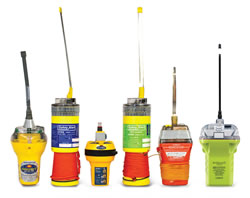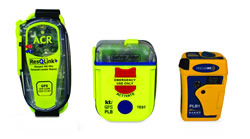Distress beacons, such as Emergency Position Indicating Radio Beacons (EPIRBs) and Personal Locator Beacons (PLBs), are devices that can be activated to alert rescuers that you are in a life threatening situation and need to be rescued.
Lives are saved each year because responsible skippers carry distress beacons.
Your EPIRB or PLB must be registered with the Australian Maritime Safety Authority (AMSA).
Types of distress beacons
Choose a beacon suitable for your vessel and activity.
An EPIRB designed for marine use will:
- float and keep the antennae above the water
- have a lanyard
- operate continuously for 48 hours.
An EPIRB should be carried in a safety grab bag or positioned in the cockpit or near the helm where it can be reached quickly in an emergency.
Your EPIRB must meet Australian Standard AS/NZS 4280.1 and have an in-date battery.
When purchasing an EPIRB, it may be wise to ensure it is Global Positioning System (GPS) enabled as this will be required by 2028. When activated, a GPS-enabled EPIRB will direct emergency services to within 100 metres of your location compared to 5 kilometres with a non-GPS device.

PLB
A PLB is a compact personal locator beacon and is designed to be worn or carried by an individual.
Some PLBs do not float and may not be designed for use in water.
A PLB usually has a shorter battery life than an EPIRB and will only operate for approximately 24hrs.
Your PLB must meet Australian Standard 4280.2 and have an in-date battery.

Distress beacon requirements
When operating more than 400 metres from shore in the ocean in unprotected waters, you must carry a GPS-enabled EPIRB or wear a GPS-enabled PLB.
Registrable vessels are vessels, including sailing vessels, that are or can be propelled by mechanical power.
Non-registrable vessels include sailboards, kiteboards, windsurfers, paddle craft, tenders and sailing dinghies.
Find out more about what safety equipment you need.
Distress beacon registration
EPIRBs and PLBs must be registered with the Australian Maritime Safety Authority (AMSA).
Registration is a free and can be completed online.
Proof of registration
You may be required to provide proof of beacon registration during an safety equipment inspection.
You can provide proof of registration, such as an email, SMS or check your registration on the AMSA website.
Update registration details
If your beacon’s registration details change you can update them on the AMSA beacon register website.
Using your EPIRB or PLB
EPIRBs and PLBs should only be used when:
- there is an emergency and you believe you are in imminent danger; or
- when you are told to do so by a rescue authority.
In the event of an emergency, you should also consider initial communications with others close by using radios and other signalling devices.
Testing EPIRBs and PLBs
You should check and test your EPIRB or PLB before going out on the water.
Check the device for signs of damage.
Use the test switch as per the manufacturer's instructions to check power and operation.
Accidental activation
If you activate your EPIRB or PLB by accident, turn it off immediately and let rescue authorities know as soon as possible by calling:
- Australian Maritime Safety Authority (AMSA) on 1800 641 792;
- WA Water Police on (08) 9442 8600; or
- nearest Marine Rescue (MR) group.
Unauthorised use of EPIRBs and PLBs
EPIRBs and PLBs must only be activated in an emergency situation.
Intentionally activating an EPIRB or PLB when you are not in distress carries a severe penalty and wastes time and resources.
Storage
EPIRBs
Store EPIRBs in an accessible place where they can be retrieved easily but away from areas where they might be knocked or accidentally activated.
When activated attach the EPIRB using the lanyard to yourself or something that will not sink.
Ensure the EPIRB container is not cracked or showing signs of damage and all on board know where it is and how to activate it.
PLBs
When out on the water, a PLB must be worn or attached to one person on board.
Your PLB must not restrict the inflation of your lifejacket.
Disposal
Do not throw your EPIRBs and PLBs in the rubbish bin. Beacons can be accidentally activated if thrown in general waste and end up in landfill.
To dispose unwanted EPIRBs or PLBs you can:
- Hand in for safe disposal at:
- Marine Operations Centre, 14 Capo D'Orlando Drive, Fremantle.
- Marine Operations Centre, Peel Region, 107 Breakwater Parade, Mandurah.
- Contact your local Battery World store to check whether they disconnect and dispose of beacons. Fees may apply.
You may disarm the beacon and disconnect the battery by following the manufacturer's instructions. Once disarmed, check with your local waste management facility for an environmentally friendly method of disposing of the battery.